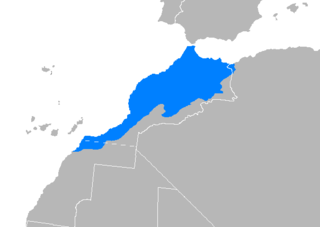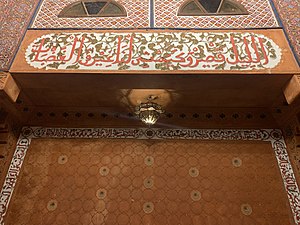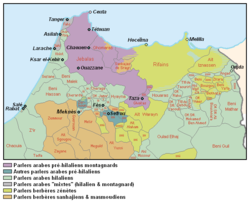
A | B | C | D | E | F | G | H | CH | I | J | K | L | M | N | O | P | Q | R | S | T | U | V | W | X | Y | Z | 0 | 1 | 2 | 3 | 4 | 5 | 6 | 7 | 8 | 9
This article may need to be rewritten to comply with Wikipedia's quality standards. (June 2017) |
| Moroccan Arabic | |
|---|---|
| Darija | |
| العربية المغربية الدارجة | |
| Pronunciation | [ddæɾiʒæ] |
| Native to | Morocco |
| Region | Western Maghreb |
| Ethnicity | Moroccans |
| Speakers | L1: 29 million (2020)[1] L2: 9.6 million (2020)[1] Total: 39 million (2020)[1] |
| Dialects | |
| Arabic alphabet | |
| Language codes | |
| ISO 639-3 | ary |
| Glottolog | moro1292 |
 Map of Moroccan Arabic[2] | |

Moroccan Arabic (Arabic: العربية المغربية الدارجة, romanized: al-ʻArabiyyah al-Maghribiyyah ad-Dārija[3] lit. 'Moroccan vernacular Arabic'), also known as Darija (الدارجة or الداريجة[3]), is the dialectal, vernacular form or forms of Arabic spoken in Morocco.[4][5] It is part of the Maghrebi Arabic dialect continuum and as such is mutually intelligible to some extent with Algerian Arabic and to a lesser extent with Tunisian Arabic. It is spoken by 90.9% of the population of Morocco.[6] While Modern Standard Arabic is used to varying degrees in formal situations such as religious sermons, books, newspapers, government communications, news broadcasts and political talk shows, Moroccan Arabic is the predominant spoken language of the country and has a strong presence in Moroccan television entertainment, cinema and commercial advertising. Moroccan Arabic has many regional dialects and accents as well, with its mainstream dialect being the one used in Casablanca, Rabat, Tangier, Marrakesh and Fez, and therefore it dominates the media and eclipses most of the other regional accents.
SIL International classifies Moroccan Arabic, Hassaniya Arabic and Judeo-Moroccan Arabic as different varieties of Arabic.
Dialects
Moroccan Arabic was formed of several dialects of Arabic belonging to two genetically different groups: pre-Hilalian and Hilalian dialects.[7][8][9]
Pre-Hilalian dialects

Pre-Hilalian dialects are a result of early Arabization phases of the Maghreb, from the 7th to the 12th centuries, concerning the main urban settlements, the harbors, the religious centres (zaouias) as well as the main trade routes. The dialects are generally classified in three types: (old) urban, "village" and "mountain" sedentary and Jewish dialects.[8][10] In Morocco, several pre-Hilalian dialects are spoken:
- Urban dialects: Old dialects of Fes, Rabat, Salé, Taza, Tétouan, Wezzan, Chefchaouen, Tangier, Asilah, Larache, Ksar el-Kebir, Meknes and Marrakesh.[11][9][12]
- Jebli dialects: Dialects of northwestern Morocco, spoken by the Jebala people.[9][13]
- Sedentary ("village") dialects of Zerhoun and Sefrou and their neighboring tribes (Zerahna tribe for Zerhoun; Kechtala, Behalil and Yazgha tribes for Sefrou), remnants of pre-Hilalian dialects that were more widely spoken before the 12th century.
- Judeo-Moroccan, nearly extinct, formerly spoken by Moroccan Jews.[14]
Hilalian dialects
Hilalian dialects (Bedouin dialects) were introduced following the migration of Arab nomadic tribes to Morocco in the 11th century, particularly the Banu Hilal, which the Hilalian dialects are named after.[15][10]
The Hilalian dialects spoken in Morocco belong to the Maqil subgroup,[10] a family that includes three main dialectal areas:
- 'Aroubi Arabic (Western Moroccan Arabic): spoken in the western plains of Morocco by Doukkala, Abda, Tadla, Chaouia, Gharb, and Zaers, and in the area north of Fes by Hyayna, Cheraga, Awlad Jama', etc.
- Eastern Moroccan Arabic: spoken in Oujda, the Oriental region and western Algeria (central and western Oranie[16])
- New urban dialects: predominantly Hilalian urban dialects, resulting from the migration movements from the countryside to cities in 20th century.[12]
- Hassaniya Arabic: spoken in southern Morocco, Western Sahara and Mauritania).[17] Among the dialects, Hassaniya is often considered as distinct from Moroccan Arabic.
Phonology
Vowels
| Short | Long | ||||
|---|---|---|---|---|---|
| Front | Central | Back | Front | Back | |
| Close | ə | u | iː | uː | |
| Mid | |||||
| Open | aː | ||||
One of the most notable features of Moroccan Arabic is the collapse of short vowels. Initially, short /a/ and /i/ were merged into a phoneme /ə/ (however, some speakers maintain a difference between /a/ and /ə/ when adjacent to pharyngeal /ʕ/ and /ħ/). This phoneme (/ə/) was then deleted entirely in most positions; for the most part, it is maintained only in the position /...CəC#/ or /...CəCC#/ (where C represents any consonant and # indicates a word boundary), i.e. when appearing as the last vowel of a word. When /ə/ is not deleted, it is pronounced as a very short vowel, tending towards in the vicinity of emphatic consonants, in the vicinity of pharyngeal /ʕ/ and /ħ/ (for speakers who have merged /a/ and /ə/ in this environment), and elsewhere. Original short /u/ usually merges with /ə/ except in the vicinity of a labial or velar consonant. In positions where /ə/ was deleted, /u/ was also deleted, and is maintained only as labialization of the adjacent labial or velar consonant; where /ə/ is maintained, /u/ surfaces as . This deletion of short vowels can result in long strings of consonants (a feature shared with Amazigh and certainly derived from it). These clusters are never simplified; instead, consonants occurring between other consonants tend to syllabify, according to a sonorance hierarchy. Similarly, and unlike most other Arabic dialects, doubled consonants are never simplified to a single consonant, even when at the end of a word or preceding another consonant.
Some dialects are more conservative in their treatment of short vowels. For example, some dialects allow /u/ in more positions. Dialects of the Sahara, and eastern dialects near the border of Algeria, preserve a distinction between /a/ and /i/ and allow /a/ to appear at the beginning of a word, e.g. /aqsˤarˤ/ "shorter" (standard /qsˤərˤ/), /atˤlaʕ/ "go up!" (standard /tˤlaʕ/ or /tˤləʕ/), /asˤħaːb/ "friends" (standard /sˤħab/).
Long /aː/, /iː/ and /uː/ are maintained as semi-long vowels, which are substituted for both short and long vowels in most borrowings from Modern Standard Arabic (MSA). Long /aː/, /iː/ and /uː/ also have many more allophones than in most other dialects; in particular, /aː/, /iː/, /uː/ appear as , , in the vicinity of emphatic consonants and [q], [χ], [ʁ], [r], but , , elsewhere. (Most other Arabic dialects only have a similar variation for the phoneme /aː/.) In some dialects, such as that of Marrakech, front-rounded and other allophones also exist. Allophones in vowels usually do not exist in loanwords.
Emphatic spreading (i.e. the extent to which emphatic consonants affect nearby vowels) occurs much less than in Egyptian Arabic. Emphasis spreads fairly rigorously towards the beginning of a word and into prefixes, but much less so towards the end of a word. Emphasis spreads consistently from a consonant to a directly following vowel, and less strongly when separated by an intervening consonant, but generally does not spread rightwards past a full vowel. For example, /bidˤ-at/ "eggs" (/i/ and /a/ both affected), /tˤʃaʃ-at/ "sparks" (rightmost /a/ not affected), /dˤrˤʒ-at/ "stairs" (/a/ usually not affected), /dˤrb-at-u/ "she hit him" (with variable but tending to be in between and ; no effect on /u/), /tˤalib/ "student" (/a/ affected but not /i/). Contrast, for example, Egyptian Arabic, where emphasis tends to spread forward and backward to both ends of a word, even through several syllables.
Emphasis is audible mostly through its effects on neighboring vowels or syllabic consonants, and through the differing pronunciation of /t/ t͡s and /tˤ/ t. Actual pharyngealization of "emphatic" consonants is weak and may be absent entirely. In contrast with some dialects, vowels adjacent to emphatic consonants are pure; there is no diphthong-like transition between emphatic consonants and adjacent front vowels.
